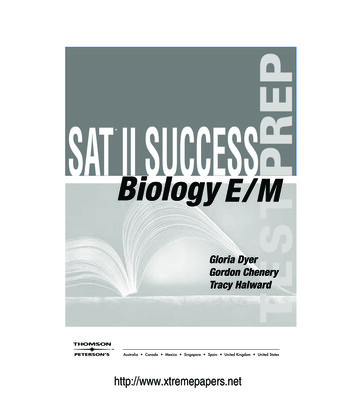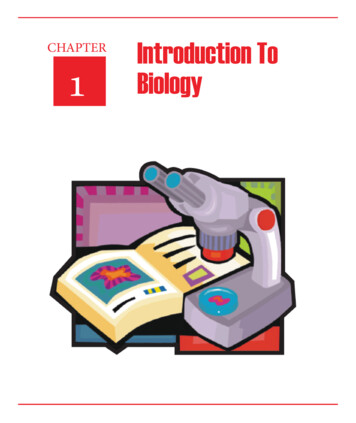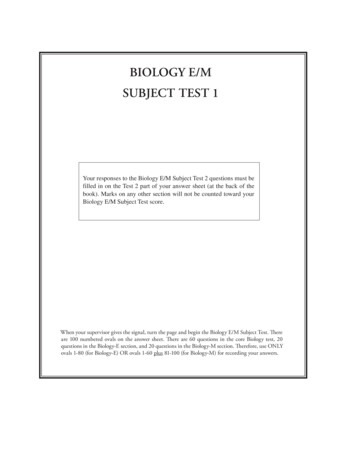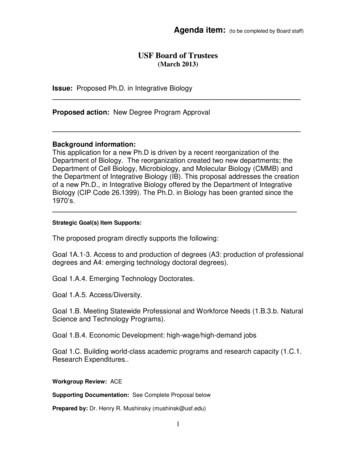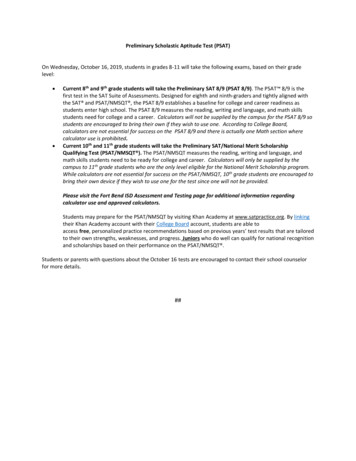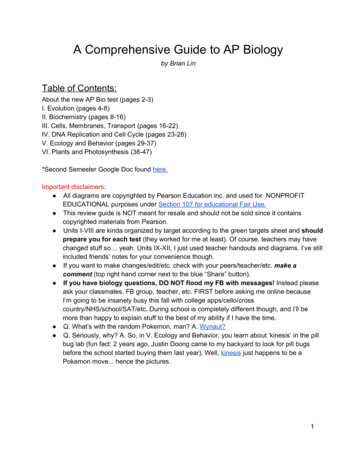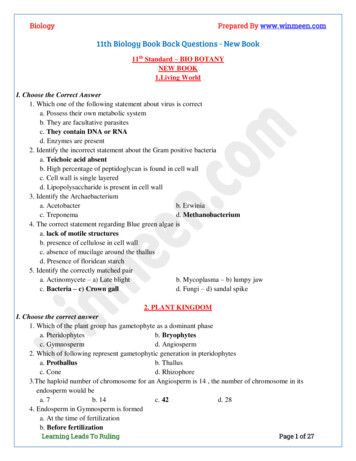
Transcription
BiologyPrepared By www.winmeen.com11th Biology Book Back Questions - New Book11th Standard – BIO BOTANYNEW BOOK1.Living WorldI. Choose the Correct Answer1. Which one of the following statement about virus is correcta. Possess their own metabolic systemb. They are facultative parasitesc. They contain DNA or RNAd. Enzymes are present2. Identify the incorrect statement about the Gram positive bacteriaa. Teichoic acid absentb. High percentage of peptidoglycan is found in cell wallc. Cell wall is single layeredd. Lipopolysaccharide is present in cell wall3. Identify the Archaebacteriuma. Acetobacterb. Erwiniac. Treponemad. Methanobacterium4. The correct statement regarding Blue green algae isa. lack of motile structuresb. presence of cellulose in cell wallc. absence of mucilage around the thallusd. Presence of floridean starch5. Identify the correctly matched paira. Actinomycete – a) Late blightb. Mycoplasma – b) lumpy jawc. Bacteria – c) Crown galld. Fungi – d) sandal spike2. PLANT KINGDOMI. Choose the correct answer1. Which of the plant group has gametophyte as a dominant phasea. Pteridophytesb. Bryophytesc. Gymnospermd. Angiosperm2. Which of following represent gametophytic generation in pteridophytesa. Prothallusb. Thallusc. Coned. Rhizophore3.The haploid number of chromosome for an Angiosperm is 14 , the number of chromosome in itsendosperm would bea. 7b. 14c. 42d. 284. Endosperm in Gymnosperm is formeda. At the time of fertilizationb. Before fertilizationLearning Leads To RulingPage 1 of 27
BiologyPrepared By www.winmeen.comc. After fertilization.d. Along with the development of embryo3.VEGETATIVE MORPHOLOGYI. Choose the correct answer:1. Roots area. Descending, negatively geotropic, positively phototropicb. Descending, positively geotropic, negatively phototropicc. Ascending, positively geotropic, negatively phototropicd. Ascending, negatively geotropic, positively phototropic2. When the root is thick and fleshy, but does not take a definite shape, it said to bea. Nodulose rootb. Tubercular rootc. Moniliform rootd. Fasciculated root3. Example for negatively geotropic rootsa. Ipomoea, Dahliab. Asparagus, Ruelliac. Vitis, Portulacad. Avicennia, Rhizophora4. Curcuma amada, Curcuma domestica, Asparagus, Maranta are example ofa. Tuberous rootb. Beaded rootc. Moniliform rootd. Nodulose root5. Bryophyllum and Dioscorea are example fora. Foliar bud, apical budb. Foliar bud, cauline budc. Cauline bud, apical budd. Cauline bud, foliar bud4. REPRODUCTIVE MORPHOLOGYI. Choose the correct answer1. Vexillary aestivation is characteristic of the familya. Fabaceaeb. Asteraceaec. Solanaceaed. Brassicaceae2. Gynoecium with united carples is termed asa. Apocarpousb. Multicarpellaryc. Syncarpousd. None of the above3. Aggregate fruit develops froma. Multicarpellary,apocarpous ovaryb. Multicarpellary, syncarpous ovaryc. Multicarpellary ovaryd. Whole inflorescence4. In an inflorescence where flowers are borne laterally in an acropetal succession the position ofthe youngest floral bud shall bea. Proximalb. Distalc. Intercalaryd. Anywhere5. A true fruit is the one wherea. Only ovary of the flower develops into fruitb. Ovary and calyx of the flower develops into fruitLearning Leads To RulingPage 2 of 27
BiologyPrepared By www.winmeen.comc. Overy, calyx and thalamus of the flower develops into fruitd. All floral whorls of the flower develops into fruit5. TAXONOMY AND SYSTEMATIC BOTANYI. Choose the correct answer:1. Specimen derived from non-original collection serves as the nomenclatural type, when originalspecimen is missing. It is known asa. Holotypeb. Neotypec. Isotyped. Paratype2. Phylogenetic classification is the most favoured classification because it reflectsa. Comparative Anatomyb. Number of flowers producedc. Comparative cytologyd. Evolutionary relationships3. The taxonomy which involves the similarities and dissimilarities among the immune system ofdifferent taxa is termed asa. Chemotaxonomyb. Molecular systematicc. Serotaxonomyd. Numerical taxonomy4. Which of the following is a flowering plant with nodules containing filamentous nitrogen fixingmicro - organisms?a. Crotalaria junceab. Cycas revolutac. Cicer arietinumd. Casuarina equisetifolia5. Flowers are zygomorphic ina. Ceropegiab. Thevetiac. Daturad. Solanum6.CELL: THE UNIT OF LIFEI. Choose the correct answer:1. The two subunits of ribosomes remain united at critical ion level ofa. Magnesiumb. Calciumc. Sodiumd. Ferrous2. Sequences of which of the following is used to know the phylogenya. mRNAb. rRNAc. tRNAd. Hn RNA3. Many cells function properly and divide mitotically even though they do not havea. Plasma membraneb. cytoskeletonc. mitochondriad. Plastids4. Keeping in view the fluid mosaic model for the structure of cell membrane, which one of thefollowing statements is correct with respect to the movement of lipids and proteins from one lipidmonolayer to the othera. Neither lipid nor proteins can flip-flopb. Both lipid and proteins can flip flopc. While lipids can rarely flip-flop proteins cannotd. While proteins can flip-flop lipids cannotLearning Leads To RulingPage 3 of 27
BiologyPrepared By www.winmeen.com5. Match the columns and identify the correct option:COLUMN-ICOLUMN-II(a) Thylakoids(i) Disc-shaped sacs in Golgi apparatus(b) Cristae(ii) Condensed structure of DNA(c) Cisternae(iii) Flat membranous sacs in stroma(d) Chromatin(iv) Infoldings in 7. CELL CYCLEI. Choose the correct answer1. The correct sequence in cell cycle isa. S-M-G1-G2b. S-G1-G2-Mc. G1-S-G2-Md. M-G-G2-S2. If cell division is restricted in G1 phase of the cell cycle then the condition is known asa. S Phaseb. G2 Phasec. M Phased. G0 Phase3. Anaphase promoting complex APC is a protein degradation machinery necessary for propermitosis of animal cells. If APC is defective in human cell, which of the following is expected to occura. Chromosomes will be fragmentedb. Chromosomes will not condensec. Chromosomes will not segregated. Recombination of chromosomes will occur4. In S phase of the cell cyclea. Amount of DNA doubles in each cellb. Amount of DNA remains same in each cellc. Chromosome number is increasedd. Amount of DNA is reduced to half in each cell5. Centromere is required fora. transcriptionb. crossing overc. Cytoplasmic cleavaged. movement of chromosome towards pole6. Synapsis occur betweena. mRNA and ribosomesb. spindle fibres and centromeresc. two homologous chromosomesd. a male and a female gamete7. In meiosis crossing over is initiated ata. Diploteneb. Pachytenec. Leptotened. Zygotene8. Colchicine prevents the mitosis of the cells at which of the following stageLearning Leads To RulingPage 4 of 27
BiologyPrepared By www.winmeen.coma. Anaphaseb. Metaphasec. Prophased. interphase9. The paring of homologous chromosomes on meiosis is known asa. Bivalentb. Synapsisc. Disjunctiond. Synergids10.Anastral mitosis is the characteristic feature ofa. Lower animalsb. Higher animalsc. Higher plantsd. All living organisms.8.BIOMOLECULESI. Choose the correct answer1. The most basic amino acid isa. Arginineb. Histidinec. Glycined. Glutamine2. An example of feedback inhibition isa. Cyanide action on cytochromeb. Sulpha drug on folic acid synthesiser bacteriac. Allosteric inhibition of hexokinase by glucose-6-phosphated. The inhibition of succinic dehydrogenase by malonate3. Enzymes that catalyse interconversion of optical, geometrical or positional isomers area. Ligasesb. Lyasesc. Hydrolasesd. Isomerases4. Proteins perform many physiological functions. For example some functions as enzymes. One ofthe following represents an additional function that some proteins discharge.a. Antibioticsb. Pigment conferring colour to skinc. Pigments making colours of flowersd. Hormones9. TISSUE AND TISSUE SYSTEMI. Choose the correct answer1. Refer to the given figure and select the correct statementi. A, B, and C are histogen of shoot apeii. A Gives rise to medullary rays.iii. B Gives rise to cortexiv. C Gives rise to epidermisLearning Leads To RulingPage 5 of 27
BiologyPrepared By www.winmeen.coma. i and ii onlyb. ii and iii onlyc. i and iii onlyd. iii and iv only2. Read the following sentences and identify the correctly matched sentences.i. In exarch condition, the protoxylem lies outside of metaxylem.ii. In endarch condition, the protoxylem lie towords the centre.iii. In centarch condition, metaxylem lies in the middle of the protoxylem.iv. In mesarch condition, protoxylem lies in the middle of the metaxylem.a. i, ii and iii onlyb. ii, iii and iv onlyc. i, ii and iv onlyd. All of these3. In Gymnosperms, the activity of sieve tubes are controlled bya. Nearby sieve tube members.b. Phloem parenchyma cellsc. Nucleus of companion cells.d. Nucleus of albuminous cells.4. When a leaf trace extends from a vascular bundle in a dicot stem, what would be the arrangementof vascular tissues in the veins of the leaf?a. Xylem would be on top and the phloem on the bottomb. Phloem would be on top and the xylem on the bottomc. Xylem would encircle the phloemd. Phloem would encircle the xylem5. Grafting is successful in dicots but not in monocots because the dicots havea. Vascular bundles arranged in a ringb. Cambium for secondary growthc. Vessels with elements arranged end to endd. Cork cambium10. SECONDARY GROWTHI. Choose the Correct Answer1. Consider the following statementsIn spring season vascular cambiumi. is less activeii. produces a large number of xylary elementsiii. forms vessels with wide cavities of these,a. (i) is correct but (ii) and (iii) are not correctb. (i) is not correct but (ii) and (iii) are correctc. (i) and (ii) are correct but (iii) is not correctd. (i) and (ii) are not correct but (iii) is correct.2. Usually, the monocotyledons do not increase their girth, becausea. They possess actively dividing cambiumb. They do not possess actively dividing cambiumc. Ceases activity of cambiumd. All are correct3. In the diagram of lenticel identify the parts marked as A,B,C,DLearning Leads To RulingPage 6 of 27
BiologyPrepared By www.winmeen.coma. A. phellem, B. Complementary tissue, C. Phelloderm, D. Phellogen.b. A. Complementary tissue,B. Phellem, C. Phellogen,D. Phelloderm.c. A. Phellogen, B. Phellem,C. Phelloderm, D. complementarytissued. A. Phelloderm, B. Phellem,C. Complementary tissue,D. Phellogen4. The common bottle cork is a product ofa. Dermatogenb. Phellogenc. Xylemd. Vascular cambium5. What is the fate of primary xylem in a dicot root showing extensive secondary growth?a. It is retained in the center of the axisb. It gets crushedc. May or may not get crushedd. It gets surrounded by primary phloem11.TRANSPORT IN PLANTSI. Choose the correct answer1. In a fully turgid cella. DPD 10 atm; OP 5 atm;TP 10 atmb. DPD 0 atm; OP 10 atm;TP 10 atmc. DPD 0 atm; OP 5 atm;TP 10 atmd. DPD 20 atm; OP 20 atm;TP 10 atm2. Which among the following is correct?i. apoplast is fastest and operate in nonliving partii. Transmembrane route includes vacuoleiii. symplast interconnect the nearby cell through plasmadesmataiv. symplast and transmembrane route are in living part of the cella. i and iib. ii and iiic. iii and ivd. i, ii, iii, iv3. What type of transpiration is possible in the xerophyte Opuntia?a. Stomatalb. Lenticularc. Cuticulard. All the above4. Stomata of a plant open due toa. Influx of K b. Efflux of K c. Influx of Cld. Influx of OH5. Munch hypothesis is based ona. Translocation of food due to TP gradient and imbibition forceb. Translocation of food due to TPc. Translocation of food due to imbibition forceLearning Leads To RulingPage 7 of 27
BiologyPrepared By www.winmeen.comd. None of the above12.MINERAL NUTRITIONI. Choose the correct answer:1. Identify correct match.1. Die back disease of citrus (i) Mo2. Whip tail disease (ii) Zn3. Brown heart of turnip (iii) Cu4. Little leaf (iv) Ba. 1 (iii) 2 (ii) 3 (iv) 4 (i)b. 1 (iii) 2 (i) 3 (iv) 4 (ii)c. 1 (i) 2 (iii) 3 (ii) 4 (iv)d. 1 (iii) 2 (iv) 3 (ii) 4 (i)2. If a plant is provided with all mineral nutrients but, Mn concentration is increased, what will bethe deficiency?a. Mn prevent the uptake of Fe, Mg but not Cab. Mn increase the uptake of Fe, Mg and Cac. Only increase the uptake of Cad. Prevent the uptake Fe, Mg, and Ca3. The element which is not remobilized?a. Phosphorousb. Potassiumc. Calciumd. Nitrogen4. Match the correct combination.A Molybdenum1 ChlorophyllB Zinc2 MethionineC Magnesium3 AuxinD Sulphur4 Nitrogenasea. A-1 B-3 C-4 D-2b. A-2 B-1 C-3 D-4c. A-4 B-3 C-1 D-2d. A-4 B-2 C-1 D-35. Identify the correct statementi. Sulphur is essential for amino acids Cystine and Methionineii. Low level of N, K, S and Mo affect the cell divisioniii. Non-leguminous plant Alnus whichcontain bacterium Frankiaiv. Denitrification carried out by nitrosomonas and nitrobacter.a. I, II are correctb. I, II, III are correctc. I only correctd. all are correct13. PhotosynthesisI. Choose the correct answer:1. Assertion (A): Increasein Proton gradient inside lumen responsible for ATP synthesisReason (R): Oxygen evolving complex of PS I located on thylakoid membrane facing Stroma, releasesH ionsa. Both Assertion and Reason are True.b. Assertion is True and Reason is False.Learning Leads To RulingPage 8 of 27
BiologyPrepared By www.winmeen.comc. Reason is True and Assertion is False.d. Both Assertion and Reason are False2. Which chlorophyll molecule does not have a phytol tail?a. Chl- ab. Chl-bc. Chl- cd. Chl –d3. The correct sequence of flow of electrons in the light reaction isa. PS II, plastoquinone, cytochrome, PS I, ferredoxin.b. PS I, plastoquinone, cytochrome, PS II ferredoxin.c. PS II, ferredoxin, plastoquinone, cytochrome, PS I.d. PS I, plastoquinone, cytochrome, PS II, ferredoxin.4. For every CO2 molecule entering the C3 cycle, the number of ATP & NADPH requireda. 2ATP 2NADPHb. 2ATP 3NADPHc. 3ATP 2NADPHd. 3ATP 3NADPH5. Identify true statement regarding light reaction of photosynthesis?a. Splitting of water molecule is associate with PS I.b. PS I and PS II involved in the formation of NDPH H .c. The reaction center of PS I is Chlorophyll a with absorption peakat 680 nm.d. The reaction center of PS II is Chlorophyll a with absorption peak at 700 nm.14.RESPIRATIONI. Choose the correct answer:1. The number of ATP molecules formed by complete oxidation of one molecule of pyruvic acid isa. 12b. 13c. 14d. 15 2. During oxidation of two molecules of cytosolic NADH H , number of ATP molecules produced inplants area. 3b. 4c. 6d. 83. The compound which links glycolysis and Krebs cycle isa. succinic acidb. pyruvic acidc. acetyl CoAd. citric acid4. Assertion (A): Oxidative phosphorylation takes place during the electron transport chain inmitochondria.Reason (R): Succinyl CoA is phosphorylated into succinic acid by substrate phosphorylation.a. A and R is correct. R is correct explanation of Ab. A and R is correct but R is not the correct explanation of Ac. A is correct but R is wrongd. A and R is wrong.5. Which of the following reaction is not involved in Krebs cycle.a. Shifting of phosphate from 3C to 2Cb. Splitting of Fructose 1,6 bisphosphate of into two molecules 3C compounds.c. Dephosphorylation from the substratesd. All of theseLearning Leads To RulingPage 9 of 27
BiologyPrepared By www.winmeen.com15.PLANT GROWTH AND DEVELOPMENTI. Choose the correct answer:1. Select the wrong statement from the following:a. Formative phase of the cells retain the capability of cell division.b. In elongation phase development of central vacuole takes place.c. In maturation phase thickening and differentiation takes place.d. In maturation phase, the cells growfurther.2. If the diameter of the pulley is 6 inches, length of pointer is 10 inches and distance travelled bypointer is 5 inches. Calculate the actual growthin length of plant.a. 3inchesb. 6 inchesc. 12 inchesd. 30 inches3. In unisexual plants, sex can be changed by the application ofa. Ethanolb. Cytokininsc. ABAd. Auxin4. Select the correctly matched oneA) Human urinei) Auxin –BB) Corn gram oilii) GA3C) Fungusiii) Abscisic acid IID) Herring fishiv) Kinitin spermE) Unripe maizev) Auxin A grainsF) Young cottonvi) Zeatinbollsa) A-iii, B-iv, C-v, D-vi, E-i, F-ii,b) A-v, B-i, C-ii, D-iv, E-vi, F-iii,c) A-iii, B-v, C-vi, D-i, E-ii, F-iv,d) A-ii, B-iii, C-v, D-vi, E-iv, F-i5. Seed dormancy allows the plants toa. overcome unfavourable climaticconditionsb. develop healthy seedsc. reduce viabilityd. prevent deterioration of seeds.11th Standard – BIO ZOOLOGYNEW BOOK1.THE LIVING WORLDI. Choose the Correct Answer1. A living organism is differentiated fromnon-living structure based ona. Reproductionb. Growthc. Metabolismd. Movement2. A group of organisms having similar traits of a rank isa. Speciesb. Taxonc. Genusd. FamilyLearning Leads To RulingPage 10 of 27
BiologyPrepared By www.winmeen.com3. Every unit of classification regardless of its rank isa. Taxonb. Varietyc. Speciesd. Strain4. Which of the following is not present in same rank?a. Primatab. Orthopterac. Dipterad. Insecta5. What taxonomic aid gives comprehensive information about a taxon?a. Taxonomic Keyb. Herbariumc. Florad. Monograph6. Who coined the term biodiversity?a. Walter Rosenb. AG Tansleyc. Aristotled. AP de Candole7. Cladogram considers the following charactersa. Physiological and Biochemicalb. Evolutionary and Phylogeneticc. Taxonimic and systematicd. None of the above8. Molecular taxonomic tool consists ofa. DNA and RNAb. Mitochondria and Endocplamicreticulumc. Cell wall and Membrane proteinsd. All the above2.KINGDOM ANIMALIAI. Choose the correct answer1. The symmetry exhibited in cnidarians isa. Radialb. Bilateralc. Pentamerous radiald. Asymmetrical2. Sea anemone belongs to phyluma. Protozoab. Poriferac. Coelenteratad. Echinodermata3. The excretory cells that are found inplatyhelminthes area. Protonephridiab. Flame cellsc. Solenocytesd. All of these4. In which of the following organisms, self fertilization is seen.a. Fishb. Round wormc. Earthwormd. Liver fluke5. Nephridia of Earthworms are performing the same functions asa. Gills of prawnb. Flame cells of Planariac. Trachea of insectsd. Nematoblasts of Hydra6. Which of the following animals has a true coelom ?a. Ascarisb. Pheretimac. Sycond. Taenia solium7. Metameric segmentation is the main feature ofa. Annelidab. Echinodermatac. Arthropodad. CoelenterataLearning Leads To RulingPage 11 of 27
BiologyPrepared By www.winmeen.com8. In Pheretima locomotion occurs withhelp ofa. circular musclesb. longitudinal muscles and setaec. circular, longitudinal muscles and setaed. parapodia9. Which of the following have the highest number of species in nature?a. Insectsb. Birdsc. Angiospermsd. Fungi10. Which of the following is a crustacean?a. Prawnb. Snailc. Sea anemoned. Hydra11. The respiratory pigment in cockroach isa. Haemoglobinb. Haemocyaninc. Oxyhaemoglobind. Haemoerythrin12. Exoskeleton of which phylum consists of chitinous cuticle?a. Annelidab. poriferac. Arthropodad. Echinodermata13. Lateral line sense organs occur ina. Salamanderb. Frogc. Water snaked. Fish14. The limbless amphibian isa. Icthyophisb. Hylac. Ranad. Salamander15. Four chambered heart is present ina. Lizardb. Snakec. Scorpiond. Crocodile16. Which of the following is not correctly paired?a. Humans – Ureotelicb. Birds – Uricotelicc. Lizards – Uricotelicd. Whale – Ammonotelic17. Which of the following is an egg laying mammal?a. Delphinusb. Macropusc. Ornithorhynchusd. Equus18. Pneumatic bones are seen ina. Mammaliab. Avesc. Reptiliad. Sponges19. Match the following columns and selectthe correct option.Column – IColumn – II(p) Pila(i) Devil fish(q) Dentalium(ii) Chiton(r) Chaetopleura(iii) Apple snail(s) Octopus(iv) Tusk shella. p – (ii), q – (i), r – (iii), s – (iv)b. p – (iii), q – (iv), r – (ii), s – (i)c. p – (ii), q – (iv), r – (i), s – (iii)d. p – (i), q – (ii), r – (iii), s – (iv)20. In which of the following phyla, the adult shows radial symmetry but the larva shows bilateralLearning Leads To RulingPage 12 of 27
BiologyPrepared By www.winmeen.comsymmetry?a. Molluscab. Echinodermatac. Arthropodad. Annelida21. Which of the following is correctlymatched?a. Physalia – Portugese man of warb. Pennatula – Sea fanc. Adamsia – Sea pend. Gorgonia – Sea anemone3.TISSUE LEVEL OF ORGANISATIONI. Choose the correct answer:1. The main function of the cuboidal epithelium isa. Protectionb. Secretionc. Absorptiond. Both (b) and (c)2. The ciliated epithelium lines thea. Skinb. Digestive tractc. Gall bladderd. Trachea3. What type of fibres are found in connective tissue matrix?a. Collagenb. Areolarc. Cartilaged. Tubular4. Prevention of substances from leaking across the tissue is provided bya. Tight junctionb. Adhering junctionc. Gap junctiond. Elastic junction5. Non-shivering thermogenesis in neonates produces heat througha. White fatb. Brown fatc. Yellow fatd. Colourless fat4.ORGAN AND ORGAN SYSTEMS IN ANIMALSI. Choose the correct answer1. The clitellum is a distinct part in thebody of earthworm Lampito mauritii,it is found in?a. Segments 13 – 14b. Segments 14 – 17c. Segments 12 – 13d. Segments 14 - 162. Sexually, earthworms area. Sexes are separateb. Hermaphroditic but not self -fertilizingc. Hermaphroditic and self – fertilizing d. Parthenogenic3. To sustain themselves, earthworms mustguide their way through the soil using their powerfulmuscles. They gather nutrients by ingesting organic matter and soil,absorbing what they need intotheir bodies.True or False: The two ends of the earthworm can equally ingest soil.a. Trueb. False4. The head region of Cockroach pairs of and shaped eyes occur.a. One pair, sessile compound and kidney shapedb. Two pairs, stalked compound andround shapedLearning Leads To RulingPage 13 of 27
BiologyPrepared By www.winmeen.comc. Many pairs, sessile simple and kidney shapedd. Many pairs, stalked compound and kidney shaped5. The location and numbers of malpighian tubules in Periplaneta.a. At the junction of midgut and hindgut, about 150.b. At the junction of foregut and midgut, about 150.c. Surrounding gizzard, eight.d. At the junction of colon and rectum,eight.6. The type of vision in Cockroach isa. Three dimensionalb. Two dimensionalc. Mosaicd. Cockroach do not have vision7. How many abdominal segments are present in male and female Cockroaches?a. 10, 10b. 9, 10c. 8, 10d. 9, 98. Which of the following have an open circulatory system?a. Frogb. Earthwormc. Pigeond. Cockroach9. Buccopharyngeal respiration in froga. is increased when nostrils are closedb. Stops when there is pulmonaryrespirationc. is increased when it is catching flyd. stops when mouth is opened.10. Kidney of frog isa. Archinephrosb.Pronephrosc. Mesonephrosd. Metanephros11. Presence of gills in the tadpole of frog indicates thata. fishes were amphibious in the pastb. fishes involved from frog –like ancestorsc. frogs will have gills in futured. frogs evolved from gilled ancestor12. Choose the wrong statement among the following:a. In earthworm, a single male genital pore is present.b. Setae help in locomotion ofearthworms.c. Muscular layer in the body wall of earthworm is made up of only circular muscles.d. Typhlosole is part of the intestineof earthworm.13. Which of the following are the senseorgans of Cockroach?a. Antennae, compound eyes,maxillary palps, anal cercib. Antennae, compound eye,maxillary palpsc. Antennae, ommatidia, maxillarypalps, sternumd. Antennae, eyes, maxillary palps,and tarsus of walking legs5. DIGESTION AND ABSORPTIONLearning Leads To RulingPage 14 of 27
BiologyPrepared By www.winmeen.comI. Choose the correct answer:1. Choose the incorrect sentence from the following:a. Bile juice emulsifies the fat.b. Chyme is a digestive acidic food in stomach.c. Pancreatic juice converts lipid into fatty acid and glycerol.d. Enterokinase stimulates the secretion of pancreatic juice.2. What is chyme .?a. The process of conversion of fat into small droplets.b. The process of conversion of micelles substances of glycerol into fatty droplet.c. The process of preparation of incompletely digested acidic food through gastric juice.d. The process of preparation of completely digested liquid food in midgut.3. Which of the following hormones stimulate the production of pancreaticjuice and bicarbonate?a. Angiotensin and epinephrineb. Gastrin and insulinc. Cholecysokinin and secretind. Insulin and glucagon4. The sphincter of Oddi guardsa. Hepatopancreatic ductb. Common bile ductc. Pancreatic ductd. Cystic duct5. In small intestine, active absorption occurs in case ofa. Glucoseb. Amino acids c. Nad. All the above6. Which one is incorrectly matched?a. Pepsin – stomachb. Renin – liverc. Trypsin – intestined. Ptyalin – mouth7. Absorption of glycerol, fatty acids and monoglycerides takes place bya. Lymph vessels within villib. Walls of stomachc. Colond. Capillaries within villi8. First step in digestion of fat isa. Emulsificationb. Enzyme actionc. Absorption by lactealsd. Storage in adipose tissue9. Enterokinase takes part in the conversion ofa. Pepsinogen into pepsinb. Trypsinogen into trypsinc. Protein into polypeptided. Caseinogen into casein10. Which of the following combinations are not matched?Column IColumn IIa.Bilirubin and biliverdin(i) intestinal juiceb.Hydrolysis of starch(ii) Amylasesc. Digestion of fat(iii) Lipasesd. Salivary gland(iv) Parotid11. Match column I with column II and choose the correct optionColumn – IColumn – II(P) Small intestine(i) Largest factory(Q) Pancreas(ii) Absorpstion of glucoseLearning Leads To RulingPage 15 of 27
BiologyPrepared By www.winmeen.com(R) Liver(iii) Carrying electrolytic solution(S) Colon(iv) Digestion and absorptiona. ( P-iv ) ( Q -iii ) ( R- i ) ( S – ii )b. ( P-iii ) ( Q -ii ) ( R- i ) ( S – iv )c. ( P-iv ) ( Q -iii ) ( R- i ) ( S – ii )d. ( P-ii ) ( Q -iv ) ( R- iii ) ( S – i )12. Match column I with column II and choose the correct optionColumn – IColumn – II(P) Small intestine(i) 23 cm(Q) Large intestine(ii) 4 meter(R) Oesophagus(iii) 12.5 cm(S) Pharynx(iv) 1.5 metera. ( P-iv ) ( Q -ii ) ( R- i ) ( S – iii )b. ( P-ii ) ( Q -iv ) ( R- i ) ( S – iii )c. ( P-i ) ( Q -iii ) ( R- ii ) ( S – iv )d. ( P-iii ) ( Q -i ) ( R- ii ) ( S – iv )13. Match column I with column II and choose the correct optionColumn – IColumn – II(P) Lipase(i) Starch(Q) Pepsin(ii) Cassein(R) Renin(iii) Protein(S) Ptyalin(iv) Lipida. ( P-iv ) ( Q -ii ) ( R- i ) ( S – iii )b. ( P-iii ) ( Q -iv ) ( R- ii ) ( S – i )c. ( P-iv ) ( Q -iii ) ( R- ii ) ( S – i )d. ( P-iii ) ( Q -ii ) ( R- iv ) ( S – i )14. Which of the following is not the function of liver?a. Production of insulinb. Detoxificationc. Storage of glycogend. Production of bile15. Assertion : (A) Large intestine also shows the presence of villi like small intestine.Reason: (B) Absorption of water takes place in large intestine.a. Both A and B are true and B is the correct explanation of Ab. Both A and B are true but B is notthe correct explanation of Ac. A is true but B is falsed. A is false but B is true16. Which of the following is not true regarding intestinal villi?a. They possess microvilli.b. They increase the surface area.c. They are supplied with capillaries and the lacteal vessels.d. They only participate in digestion of fats.6.RESPIRATIONI. Choose the correct answer:1. Breathing is controlled bya. cerebrumb. medulla oblongatac. cerebellumd. pons2. Intercostal muscles are found between thea. vertebral columnb. sternumLearning Leads To RulingPage 16 of 27
BiologyPrepared By www.winmeen.comc. ribsd. glottis3. The respiratory structures of insectsarea. tracheal tubesb. gillsc. green glandsd. lungs4. Asthma is caused due toa. bleeding in pleural cavity.b. infection of nosec. damage of diaphragm.d. infection of lungs5. The Oxygen Dissociation Curve isa. sigmoidb. straight linec. curvedd. rectangular hyperbola6. The Tidal Volume of a normal person isa. 800 mLb. 1200 mLc. 500 mLd. 1100 – 1200 mL7. During inspiration, the diaphragma. expands.b. unchangedc. relaxes to become domed–shaped.d. contracts and flattens8. CO2 is transported through blood to lungs asa. carbonic acidb. oxyhaemoglobinc. carbamino haemoglobind. carboxy haemoglobin9. When 1500 mL air is in the lungs, it is calleda. vital capacityb. tidal volumec. residual volumed. inspiratory reserve volume10. Vital capacity isa. TV IRVb. TV ERVc. RV ERVd. TV IRV ERV11. After a long deep breath, we do not respire for some seconds due toa. more CO2 in the bloodb. more O2 in the bloodc. less CO2 in the bloodd. less O2 in the blood12. Which of the following substances in tobacco smoke damage the gas exchange system?a. carbon monoxide and carcinogensb. carbon monoxide and nicotinec. carcinogens and tard. nicotine and tar13. Column I represents diseases andcolumn II represents their symptoms.Choose the correctly pairedoptionColumn IColumn II(P) Asthma(i) Recurring ofbronchitis(Q) Emphysema(ii) Accumulation of W.B.CS in alveolus(R) Pneumonia(iii) Allergya. P iii, Q ii, R ib. P iii, Q i, R iic. P ii, Q iii, R id. P ii, Q i, R iii14. Which of the following best describes the process of gas exchange in the lungs?a. Air moves in and out of the alveoliduring breathing.b. Carbon dioxide diffuses fromdeoxygenated blood in capillariesinto the alveolar air.Learning Leads To RulingPage 17 of 27
BiologyPrepared By www.winmeen.comc. Oxygen and carbon dioxide diffuse down their concentration gradients between blood andalveolar air.d. Oxygen diffuses from alveolar airinto deoxygenated blood.15. Make the correct pairs.Column–IColumn–II(P) ICi. maximum volume of air breathes in after forced.(Q) ECii. Volume of air present after expiration in lungs.(R) VCiii. Volume of air inhaled after expiration.(S) FRCiv. Volume of air exhaled after inspiration.(a) P – i , Q – ii , R – iii , S – iv(b) P – ii , Q – iii , R – iv , S – i(c) P – ii , Q – iii , R – i , S – iv(d) P –
Biology Prepared By www.winmeen.com Learning Leads To Ruling Page 1 of 27 11th Biology Book Back Questions - New Book 11th Standard - BIO BOTANY NEW BOOK 1.Living World I. Choose the Correct Answer 1. Which one of the following statement about virus is correct .
